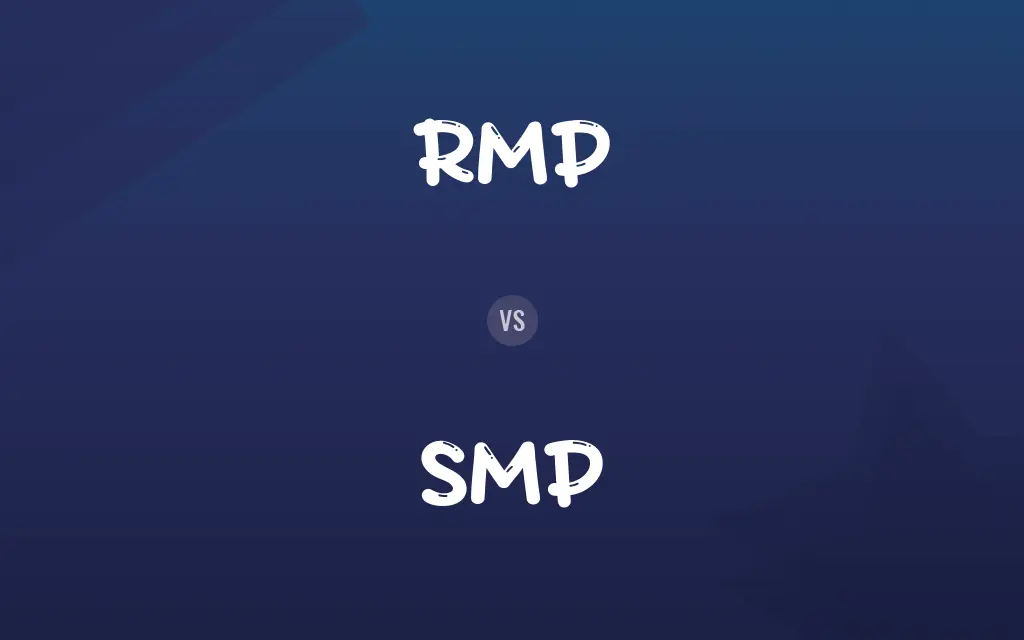RMP vs. SMP: Difference and Comparison
Edited by Muazma Batool — By Muneeza Rehman — Published on March 3, 2024
RMP (Risk Management Plan) focuses on identifying, assessing, and mitigating risks in projects or organizations; SMP (Safety Management Plan) concentrates on creating procedures and policies to ensure workplace safety and health.

Difference Between RMP and SMP
RMP (Risk Management Plan) and SMP (Safety Management Plan) serve distinct but complementary purposes within an organization. An RMP outlines strategies to identify, assess, mitigate, and monitor risks that could impact an organization's operations or project success. On the other hand, an SMP is specifically designed to address safety and health concerns in the workplace. It includes the development and implementation of policies, practices, and procedures to prevent accidents and injuries, ensuring a safe working environment for employees.
Muneeza Rehman
Mar 03, 2024
Both plans are essential for organizational governance, an RMP has a broader scope encompassing various types of risks beyond safety, including those that may affect financial health or reputational standing. In contrast, an SMP zeroes in on physical safety and health, directly impacting employees' well-being and workplace conditions.
Muneeza Rehman
Mar 03, 2024
Implementing both an RMP and an SMP allows organizations to comprehensively address the spectrum of risks and safety issues, ensuring not only the strategic management of potential threats to business continuity but also prioritizing the health and safety of its workforce.
Muneeza Rehman
Mar 03, 2024
Integration of RMP and SMP efforts can enhance organizational resilience, creating a proactive culture of safety and risk awareness. By addressing both strategic risks and safety concerns, organizations can better safeguard their assets, employees, and stakeholders against a wide range of potential adverse events.
Levi
Mar 03, 2024
RMP vs. SMP Comparison Chart
Purpose
To identify, assess, mitigate, and monitor risks across various domains
To ensure workplace safety and health through policies and procedures
Muneeza Rehman
Mar 03, 2024
Scope
Broad, covering financial, strategic, operational, and compliance risks
Focused on physical safety and health in the workplace
Muneeza Rehman
Mar 03, 2024
Regulatory Compliance
May be required in certain industries; focuses on comprehensive risk management
Often mandated by law; focuses on meeting specific safety standards and regulations
Muneeza Rehman
Mar 03, 2024
Implementation
Across all organizational levels, addressing diverse risks
Primarily in operational settings, targeting safety and health measures
Muneeza Rehman
Mar 03, 2024
Outcome
Minimization of potential negative impacts on organizational operations
Prevention of accidents and injuries, ensuring a safe working environment
Leo
Mar 03, 2024
RMP vs. SMP Definitions
◉RMP
Essential for informed decision-making.
Decisions are made with a clear understanding of risks thanks to our RMP.
Lucas
Feb 20, 2024
◉SMP
Critical for a safe working environment.
A robust SMP is the backbone of our safety culture.
Jonathan
Feb 20, 2024
◉RMP
Framework for risk identification and mitigation.
The RMP helped us navigate through financial uncertainties.
Muneeza Rehman
Feb 20, 2024
◉SMP
Involves employee training on safety practices.
All employees undergo safety training as part of the SMP.
Muneeza Rehman
Feb 20, 2024
◉RMP
Involves risk assessment and control strategies.
Our RMP includes a detailed risk assessment matrix.
Muneeza Rehman
Feb 20, 2024
◉SMP
Ensures workplace safety through specific policies.
Our SMP has significantly reduced workplace accidents.
Muneeza Rehman
Feb 20, 2024
◉RMP
Applies to various risk categories.
The RMP addresses risks from operational disruptions to cyber threats.
Muneeza Rehman
Feb 20, 2024
◉SMP
Focuses on health and safety regulations.
The SMP ensures compliance with OSHA standards.
Muneeza Rehman
Feb 20, 2024
◉RMP
Aims for organizational resilience.
The RMP has been crucial in our strategic planning for resilience.
Muneeza Rehman
Feb 20, 2024
◉SMP
Aimed at accident and injury prevention.
The SMP's goal is zero workplace injuries.
Levi
Feb 20, 2024
RMP vs. SMP Frequently Asked Questions
What's the difference between RMP and SMP in terms of their focus?
RMP focuses on identifying and managing a broad range of risks, while SMP is specifically aimed at ensuring workplace safety and health.
Muneeza Rehman
Mar 03, 2024
How often should RMP and SMP be reviewed and updated?
Both should be regularly reviewed and updated to reflect changes in the operational environment, regulatory requirements, and emerging risks or safety concerns.
Leo
Mar 03, 2024
Do RMP and SMP require specialized teams for their implementation?
Implementing RMP and SMP typically involves specialized teams or individuals with expertise in risk management and workplace safety, respectively.
Muneeza Rehman
Mar 03, 2024
Can RMP and SMP overlap in an organization?
Yes, there can be overlap, especially in areas related to safety risks, where implementing safety measures can also be a part of risk mitigation strategies.
Muneeza Rehman
Mar 03, 2024
How does technology impact the effectiveness of RMP and SMP?
Technology plays a crucial role in enhancing the effectiveness of both RMP and SMP. For RMP, technology can provide tools for risk identification, analysis, and monitoring, such as data analytics and risk management software. For SMP, technology can improve safety training through virtual reality simulations, monitor workplace conditions in real-time, and facilitate incident reporting and investigation.
William
Mar 03, 2024
Are RMP and SMP required by law?
SMP is often legally required, especially in industries with high safety risks. RMP may be required in certain regulatory environments but is generally adopted as a best practice.
Muneeza Rehman
Mar 03, 2024
How do RMP and SMP interact with other organizational policies and procedures?
RMP and SMP should be integrated with other organizational policies and procedures to ensure a cohesive approach to risk and safety management. This includes alignment with human resources policies, operational procedures, emergency response plans, and business continuity planning.
Henry
Mar 03, 2024
How do RMP and SMP contribute to organizational success?
By mitigating risks and ensuring a safe working environment, RMP and SMP contribute to organizational stability, employee well-being, and regulatory compliance, thereby supporting long-term success.
William
Mar 03, 2024
What are some common challenges in implementing RMP and SMP?
Common challenges include ensuring comprehensive risk identification and analysis, maintaining up-to-date and compliant safety procedures, fostering a culture of risk awareness and safety, and securing sufficient resources for effective implementation.
Jonathan
Mar 03, 2024
What role do employees play in the success of RMP and SMP?
Employees play a critical role in the success of both RMP and SMP. Their active participation in risk identification, adherence to safety protocols, and engagement in training and awareness programs are vital.
Leo
Mar 03, 2024
Content Creators
Written by
Muneeza RehmanAt Comparisons.wiki, Muneeza skillfully navigates the vast sea of information, ensuring clarity and accuracy as the lead content editor. With a keen eye for detail, she curates every comparison to enlighten and engage readers.
Edited by
Muazma BatoolAs a content editor, Muazma Batool is not just a grammar guru but a creative mastermind who breathes life into every word. With an eagle eye for detail and a passion for storytelling, she transforms bland text into engaging content that captivates audiences and drives results.

































